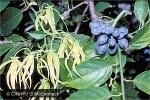Cook Islands Biodiversity Database
Species Page
Cananga odorata
Mata‘oiPerfume Tree
Multimedia & Additional Resources
| Type | Description | Download |
| Leaves, flowers and fruit | 73KB | |
| Leaf and flowers | 79KB |
General Information
Cook Islands Distribution
| Southern Group: Present Makatea: Present | ||||||||
RR |
MG |
AT |
MK |
MT |
AK |
PL |
TK |
MN |
+ |
+ |
+ |
+ |
+ |
++ |
- |
- |
- |
| Northern Group: | |||||
TN |
MH |
RK |
PK |
NS |
SW |
- |
- |
- |
- |
- |
- |
Scientific Taxonomy
Cananga odorata (Lam.)
SYNONYMS: Canangium odoratum
TAXONOMY: PLANTAE; ANTHOPHYTA (=Angiospermae); MAGNOLIOPSIDA (=Dicotyledones); MAGNOLIIDAE; Magnoliales; ANNONACEAE
More Information
SIGNIFICANCE NOTES -
BIODIVERSITY: Locally endangered. Comment: Rare in inland forests and rare in culivation. NBSAP - Mitiaro (4= of 6 domestic plants), NBSAP - Atiu (4 of 5 wild)
POSITIVE SIGNIFICANCE: Medicine, Ornamental flowers. Comments: Flowers are used to scent Coconut oil, and for making ‘Ei (garlands). Timber is sometimes used for posts and house parts, it is very light and soft; cannot be nailed though glues well; and is apparently not attacked by borer.
NEGATIVE SIGNIFICANCE: Invasive - moderate
GENERAL NOTE: Introduction - recent or Polynesian? Cheeseman (1899) concluded it was Polynesian Introduced on Rarotonga, as did Setchell in 1924 for Samoa. The traditional names support an ancient introduction: Makosoi / mokohoi (Fiji - plus other cognates), Mosokoi (Futuna) Mohokoi (Tonga), Moso‘io (Samoa) and Mata‘oi / Moto‘oi / Motoī (S.Cooks). A.C.Smith (Flora Vitiensis Nova) has the Perfume Tree as native to the Solomons, and an aboriginal introduction to Fiji and eastward.
Mature greenish-yellow flowers are strongly scented, especially in the morning. The fruits are popular food for fruit-doves and pigeons.
Vouchers & References
Vouchers:
None Recorded.
References:
p.357 Neal - In Gardens of Hawaii
p.216 Hortus 3rd
p.202 Royal Hort. Soc. Index of Garden Plants
p.72 Tropica
p.2/037 A.C.Smith - Flora Vitiensis Nova
p.271 A Cheeseman - Flora of Rarotonga
p.51 * Wilder - Flora of Rarotonga
p.377b Whistler - Ethnobotany of the Cook Islands
Data Update History (information):
zTX, zB02, zM02, zD02
Web Resources
Citation Information
McCormack, Gerald (2007) Cook Islands Biodiversity Database, Version 2007.2. Cook Islands Natural Heritage Trust, Rarotonga. Online at http://cookislands.bishopmuseum.org. ![]()
Please refer to our use policy.

